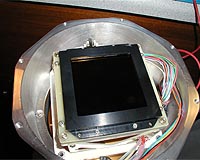 |
Beijing, China (XNA) Jan 14, 2010 The "Lunar Probe Project" won a special award at the National Science and Technology Awards held during the China National Science and Technology Meeting January 11. Ouyang Ziyuan, chief scientist of China's Lunar Probe Project disclosed during an interview that the resolution of the cameras mounted on the Chang'e-2 Satellite which has been scheduled to be launched this year reached 7 meters, and even 1 meter when the satellite is closer to the moon. Chang'e-2 will be launched at the end of this year. Ouyang said that as an early guiding satellite of the Lunar Probe Project, Chang'e-2 has a key task of conducting various tests such as landing tests. It will experience many orbital changes and adjustments. In addition, it will also carefully explore a landing zone enabling future satellites to land on the moon safely. As for the upgrading of relevant instruments which will be mounted on the satellite, Ouyang said that the resolution of the cameras installed on Chang'e-2 has reached 7 meters, a notable improvement compared to the 120-meter resolution of the Chang'e-1 Satellite. He added that the accuracy can even reach 1 meter when the satellite is closer to the moon. To date, the exact launch date of the Chang'e-3 Satellite has yet to be determined. Ouyang said that the landing of Chang'e-3 on the moon will need the cooperation of landers and lunar vehicles, which is the real key for the second phase of the Chang'e Lunar Exploration Program. "Not only can China's spacecraft reach the moon, but it can also land on the moon, laying a solid foundation for future manned and sample return missions. The future work will be tougher," Ouyang added. "How can we use resources on the moon to solve the energy crisis on the earth? This is just a topic that we are studying," Ouyang said. To date, China's "Lunar Probe Project" has explored that there is about 1 million tons of Helium-3 on the moon's surface that could meet mankind's energy demand. Scientists have a responsibility to evaluate the outlook for future energy such as the utilization of nuclear energy. Ouyang said that there are only a little more than 10 tons of Helium-3 on the earth. On the moon however, as the moon's surface is being exposed to solar radiation, solar winds can always supply the moon with Helium-3 particles and store them on the surface. Meeting China's power demand need only consume only 8 tons of Helium-3, equivalent to 220 million tons of oil or about 1 billion tons of coal. "Coal, oil, natural gas will all eventually be used up, so it is worth considering using the resources on the moon to support development on Earth. This still remains an ideal, and nuclear fusion power generation will not be commercialized for about another 50 years."
Source: Xinhua News Agency
Share This Article With Planet Earth
Related Links China Association for Science and Technology Space Technology News - Applications and Research
 XMM-Newton Sensors Celebrate A Decade Of Discovery
XMM-Newton Sensors Celebrate A Decade Of DiscoveryParis, France (ESA) Jan 08, 2010 On 10th December 1999, e2v Charge Coupled Device (CCD) imaging sensors were launched into space onboard Ariane 5 on the European Space Agency's (ESA) x-ray Multi-Mirror Mission (XMM-Newton) X-ray observatory satellite. In its decade of operation the Space telescope has supplied masses of new data which has widened our knowledge of the universe. The satellite itself carries six instruments ... read more |
|
| The content herein, unless otherwise known to be public domain, are Copyright 1995-2009 - SpaceDaily. AFP and UPI Wire Stories are copyright Agence France-Presse and United Press International. ESA Portal Reports are copyright European Space Agency. All NASA sourced material is public domain. Additional copyrights may apply in whole or part to other bona fide parties. Advertising does not imply endorsement,agreement or approval of any opinions, statements or information provided by SpaceDaily on any Web page published or hosted by SpaceDaily. Privacy Statement |